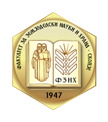MINERAL RATIOS IN BEETROOT UNDER DIFFERENT FERTILIZATION
Keywords:
Beta vulgaris var. conditiva Alef., iron, manganese, nutrient, phosphorus.Abstract
Besides the absolute values of mineral content in plant tissue, particularly is important their relative relationship. Imbalance in nutrient uptake very often is result of extensive fertilization with one nutrient, which is then in excess, so can prevent uptake of other nutrients what may cause disturbances in metabolism. Therefore, the goal of present research was to determine the influence of fertilization on mineral ratios in beetroot. A field trial (2003-2005) was set up in a hilly part of Croatia according to the Latin square method with four types of fertilization (control, 50 t stable manure ha-1, 500 and 1000 kg NPK 5-20-30 ha-1). Some investigated ratios ranged as follows: N+P+K 4.08-8.17, K+Ca+Mg 2.83-5.14, K/Ca 6.8-18.1, K/Mg 4.3-19.3, K/(Ca+Mg) 2.6-9.3, (N+P)/K 0.70-1.26, Ca/P 0.7-2.0, Ca/Mg 0.65-1.07, K/Mn 297-789, N/Zn 501-786, P/Zn 41-92, Fe/Mn 1.6-2.8, Fe/Cu 1123, Fe/(Cu+Zn) 2.1-4.2, Zn/Cu 3.3-7.6, Mn/Zn 1.5-1.8, Mn/Fe 0.38-0.62. In order to achieve high mineral content and its favorable ratio is necessary to combine the organic and mineral fertilizers with foliar fertilization.
References
AOAC. (1995). Officinal method of analysis of AOAC International. 16th Edition, Vol. I, Arlington, USA.
Bergmann W. (1992). Nutritional disorders of plants. Gustav Fischer Verlag Jena, Stuttgart, New York.
Dosid, T., Karažija, T., Čoga, L., Petek, M., Poljak, M., Herak Dustid, M., Jurkid, V., Pavlovid, I. and Slunjski, S. (2010). Istraživanje biljno hranidbenog kapaciteta vinograda u Bolu folijarnom analizom, Study, Department of Plant Nutrition, Zagreb.
Egner, H., Riehm, H. and Domingo W. R. (1960). Untersuchung über die chemische Bodenanalyse als Grundlage für die Beurteilung des Nahrstoffzustanden der Boden. II, Chemische Extraktionsmethoden zur Phosphor und Kaliumbestimmung - K. Lantbr. Hogsk. Annir. W.R. 1960, 26: 199-215.
Ekholm, P., Reinivuo, H., Mattila, P., Pakkala, H., Koponen, J., Happonen, A., Hellström, J. and Ovaskainen M.-J. (2007). Changes in the mineral and trace element contents of cereals, fruits and vegetables in Finland. Journal of Food Composition and Analysis. 20:487–495.
Neyroud, J. A., Amiguet, S., Andrey, G. and Evequoz, Ch. (2007). Le diagnostic foliaire en arboriculture: bilan de 20 ans d’étude. Revue suisse Vitic. Arboric. Hortic. 39 (5): 307-313.
Jarnuszewski, G. and Meller, E. (2013). Mineral element ratios in plants grown on post-bog soil fertilized with zinc and copper. Fol. Pomer. Univ. Technol. Stetin., Agric., Aliment., Pisc., Zootech., 304 (26): 25-32.
JDPZ (1966). Priručnik za ispitivanje zemljišta. Knjiga I. Kemijske metode ispitivanja zemljišta, Beograd.
Kadar I. (2000). Effect of mineral fertilisation on the element uptake of maize (Zea mays L.) on chernozem soil, II. Novenytermeles. 49(1-2):128-140.
Karažija, T. (2013). Utjecaj organskih gnojiva na ishranjenost, prinos i kvalitetu grožđa cv. Sauvignon bijeli na karbonatnim tlima. PhD thesis, Zagreb.
Krzywy, E. and Krzywy, J. (2001). The N:S and Fe:Mn ion ratios as factors indicative of the quality of crop plants obtained under the Waste 7, sulfate hydrate (VI) iron (II). Fol. Univ. Stetin., 221 Agric. 88, 133-140.
Lisiewska, Z., Kmiecik, W. and Gebczynnski P. (2006). Effects on Mineral Content of Different Methods of Preparing Frozen Root Vegetables. Food Science and Technology International, 12:497-503.
Marschner, H. (1995). Mineral nutrition of higher plants. Academic Press Limited, San Diego, CA 92101.
Mengel, K. and Kirkby, E. A. (1987). Principles of Plant Nutrition. International Potash Institute, Bern.
Drenjančevid. M. (2011). Fe-kloroza vinove loze na podunavskoj regiji. PhD thesis, Osijek.
Murawska, B., Spychaj-Fabisiak, E., Knapowski, T. and Głowacki B. (2013). Ionic equilibrium in maize grain depending on the fertilisation and soil type. Journal of Central European Agriculture, 14(4): 1518-1529.
Petek, M., Toth, N., Pecina, M., Karažija, T. and Herak Dustid, M. (2016). Macrominerals in Red Beet Root under Organic and Mineral Fertilization. Agriculturae Conspectus Scientificus, 81 (3): 173-179.
Petek, M. (2009). Mineralni sastav cikle (Beta vulgaris var. conditiva Alef.) pri organskoj i mineralnoj gnojidbi. PhD thesis, Zagreb.
Pitura, K. and Michalojc, Z. (2015). Influence of nitrogen doses on the chemical composition and proportions of nutrients in selected vegetable species. Journal of elementology, 20 (3): 667-676.
Ryser, J.P. (1982.). Vers l´utilisation pratique du diagnostic foliaire en viticulture et en arboriculture. Revue Suisse Vitic. Arboric. Hortic. 14: 49-54.
Škorid, A. (1982): Priručnik za pedološka istraživanja. Fakultet poljoprivrednih znanosti, Zagreb.
Tariq, M. and Mott, C.J.B. (2006). Effect of boron supply on the uptake od micronutrients by radish (Raphanus sativus L.). Journal of Agricultural and Biological Science, 1 (2): 1-8.



